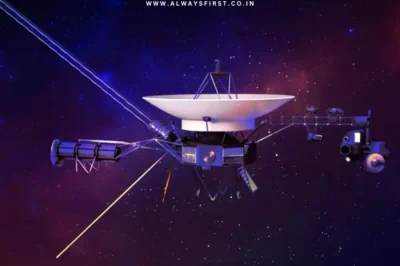Key Takeaways:
- Voyager 1 detected strange plasma waves in 1979 while crossing Jupiter’s bow shock—a boundary where solar winds meet the planet’s magnetic field.
- Jupiter’s magnetosphere is so vast that, if visible, it would appear twice the size of a full Moon from Earth.
- Newer missions like Juno continue to study Jupiter’s magnetic field, revealing even more complexity than Voyager 1 first discovered.
Voyager 1’s Haunting Discovery: Jupiter’s “Singing” Magnetosphere
When NASA’s Voyager 1 spacecraft flew past Jupiter in 1979, it didn’t just capture stunning images—it recorded something far more unexpected. As the probe crossed Jupiter’s bow shock, the boundary where the planet’s immense magnetic field deflects the Sun’s charged particles, it picked up an eerie symphony of plasma waves.
This otherworldly sound, often likened to the “music of the spheres,” wasn’t just a cosmic curiosity—it was a groundbreaking revelation about the forces shaping our solar system’s largest planet.
The Science Behind Jupiter’s “Sonic Boom”
Jupiter’s magnetosphere is the largest planetary magnetic field in our solar system, stretching up to 3 million kilometers toward the Sun and extending almost to Saturn’s orbit. When the solar wind—a stream of charged particles from the Sun—slams into this magnetic shield, it creates a shockwave, similar to a sonic boom from a supersonic jet.
Voyager 1’s crossing revealed something surprising: Jupiter’s magnetosphere was smaller than expected due to unusually strong solar winds at the time. This discovery reshaped scientists’ understanding of how planetary magnetic fields interact with space weather.
Why This Decades-Old Recording Still Matters
For over four decades, the plasma wave data from Voyager 1 has been a goldmine for researchers. The recording isn’t just a ghostly soundtrack—it’s a key to understanding how energy moves through space.
“If Jupiter’s magnetosphere glowed in visible light, it would be twice the size of the full Moon as seen from Earth,” says William Kurth, a lead scientist on the Voyager mission.
Juno & Beyond: New Missions, New Mysteries
While Voyager 1 provided the first close-up data, NASA’s Juno mission, which arrived at Jupiter in 2016, has since revealed even more complexity. Juno’s findings suggest that Jupiter’s bow shock is far more dynamic than previously thought, with fluctuating boundaries influenced by solar activity.
As scientists continue to analyze these discoveries, one thing is clear: Jupiter’s magnetic field remains one of the most fascinating—and mysterious—features in our cosmic neighborhood.






































Leave a Reply